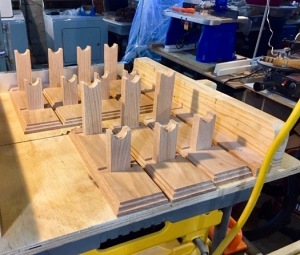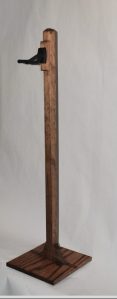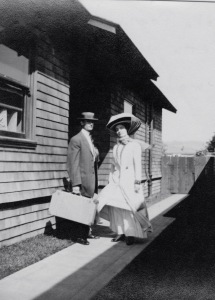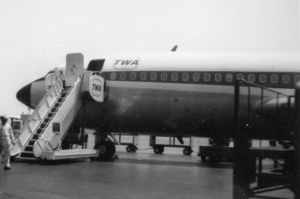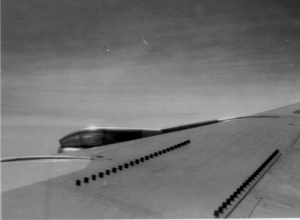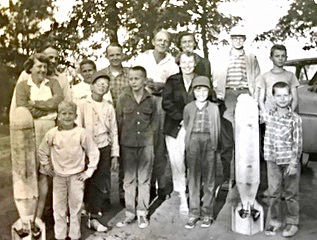
Photo Courtesy of the Baskett Family
It is vacation season once again. But, this year, things are a bit different. Many people will likely elect to stay home and relax in the back yard with their families. I’m thinking that this year we will not be traveling extensively either.
Since I’ve had a lot of spare time, I’ve spent much of it thinking about past vacations and how they sometimes were not really all the relaxing.
Sometimes they were downright stressful. For many families, the vacation was the only extended time everybody got to be together. Together in the car, together in the motels, together in the restaurants and essentially everywhere the family journeyed during those two-week expeditions across our great land.
All that togetherness can be stressful for some family members. But we’ll get to that.
My first vacations took place in the fifties. In many ways the entire concept of the modern family vacation was invented or perfected during that era.
Vacations were one of the more sacrosanct rituals in the familial liturgy of the family friendly fifties. My earliest memories include many recollections of long trips to Florida, Mississippi’s Gulf Coast and numerous other locations.
We had a copper and cream colored ’57 Chevy wagon. I want to weep thinking about what that car would be worth today. It took us on weekend trips to St. Louis and to my parent’s hometown of Hannibal, MO as well as the occasional trip into the Missouri Ozarks.
Loading the family up for one of these trips was a process. The car literally had to be “rigged” for vacation use.
Mom and Dad each worked on transforming the car from a simple station wagon into a sort of rolling family residence. My brother Bill and I were allowed to select a couple of items for the trip in the hope that we would quietly entertain ourselves and refrain from fighting in the back seat.
For longer trips, there was a mattress like affair that kid sized people like me could stretch out on and sleep away the hours as we cruised along. No one thought about seat belts then because seat belts were only found on airplanes.
My mom always packed a basket with sandwiches and fruit. There were also a couple of thermos jugs with soup or beverages.
Finally, there was that most necessary of all items, the coffee can. Rest areas had not yet been invented. The coffee-can allowed one to do their business in the privacy of the car. Pull over, do your job, empty the can on the shoulder of the road and be on your way.
Usually families would take these excursions on their own. But occasionally several families would join together and trek across the American landscape to enjoy a shared adventure.
It was during one summer in the late fifties that three families, the Burcham’s, the Baskett’s and the Washington’s set out on a joint summer vacation to the Northwoods of western Wisconsin. Our destination was Lake Minerva. A medium sized body of water located about 75 miles southwest of Duluth, Minnesota.
I was excited about this trip because my buddy, Dick Baskett would be there which meant I would have someone my own age to hang with. Dick and I had not spent a lot of time together prior to Minerva, but in later years, during college and following, we enjoyed some spectacular times engaging in numerous adventures.
Unfortunately, I can’t go into a lot of detail about those times due to Dick having kids and then there’s that whole statute of limitations thing.
I can say that the time we spent together at Lake Minerva certainly foreshadowed a future filled with fun, irreverence and dissipation.
Lake Minerva
The Lake Minerva trip was primarily a fishing trip. The cold-water lakes of the north are home to any number of game fish with the Pike and Muskie occupying the top of the pyramid of desirable catches.
I was young enough to not have an overabundance of interest in fishing. I didn’t dislike fishing, but it would not entertain me for more than an hour. After that, I would be up for doing something else. Luckily, there was plenty to do around our camp.
Each family had their own cabin. These were arranged together along the shoreline of the lake. The fishing members of our party would happily spend the entire day on the lake. Upon returning to camp, they would clean their catch in an area equipped with running water and cutting tables.
I liked watching the fish cleaning process. Afterall, what kid doesn’t love blood and guts! But, mostly, I enjoyed hearing the older guys talk about their adventures of that day.
I marveled at how the returning fishermen would always be in such a good mood. I also noticed that an enormous number of empty beer cans would come home with the catch.
In the evenings, we would usually gather together in one cabin where the parents would drink, tell stories and play cards. I recall learning to play the game of Old Maid during this trip during one rainy day when our fishermen decided to stay in and stay dry.
Unfortunately, the game of choice in the evenings was not Old Maid. So, we watched the games from the side lines. As you can imagine, watching old folks drink and play cards was not exactly exciting.
Dick and I were both getting pretty bored with watching the adults and we were way too young to drink so one evening we decided to do something else. TV was not available, so we had to depend upon our imaginations.
We wandered around the camp for a while and at some point, we ended up in our cabin. As it happened there was a large pot-bellied stove in the kitchen. Summer nights in northern Wisconsin can be quite chilly, so it only made sense that we might start a small fire in the stove to warm things up a bit.
Recently, a movie had played in Columbia called “The Great Locomotive Chase”. The movie related an event that took place during the Civil War involving a couple of wood fired steam engines chasing each other round Tennessee. It was a great movie. I remember marveling at the fire shooting out of the smokestack of the engines as they went chugging about the Confederacy.
Dick and I were talking about that movie as we fed a few pieces of wood into the stove. It wasn’t long before our imaginations took over and we were no longer standing in the kitchen of my parent’s cabin.
We were magically transported into the cab of the Virginia Central locomotive hurtling through the wilderness. We were running low on fuel, so we needed to find more in order to squeeze a few more miles per hour out of our straining puffer-belly.
We both began to run through the cabin looking for stuff that would burn so we could keep the steam up!
Periodically one of us would run outside and look at the chimney/smokestack on the roof of the cabin. We wanted to see fire shoot out of that stack just like the engines in the movie.
“More steam! We need more Steam!” we would yell as we happily tossed assorted flammable items into stove.
All of the kindling was quickly consumed. This was followed by paper towels, napkins, the contents of the waste cans and every single square of toilet paper in the cabin. All were fed into the firebox of our mighty engine.
I think maybe some magazines, a paperback book, dirty laundry and perhaps a towel or two might have been sacrificed in our quest to outrun the rebels that evening as well.
It all came to a quick end when I heard my parents coming in through the front door of the cabin. My mom loudly exclaimed, “Edward! Why is it so damn hot in here?!?”
Then came the dreaded full name request to show myself, “Louis Edward! Where are you!”
Uh Oh! It was never a good sign if the full name was used.
They were not pleased. Not pleased at all. There was a lot of yelling about how dangerous fire is and how the cabin could have burned down. Then there was the problem of no toilet paper, no paper towels, no napkins.
It seemed like the anger would never end. As more time went by, more items were discovered missing and tempers would flare up and the yelling would start again.
Dick had the good sense to bail out and return to his parent’s cabin. But we both knew we were in trouble.
We were each put in lock down. I thought this was particularly unfair. We were supposed to be on vacation. I should not have worried; it didn’t last too long. Our parents loved us. And who could blame them, after all, we were precious.
After a couple of days, they even let us wander about again without direct supervision. This was our opportunity to redeem ourselves and show that we could behave normally. A chance to demonstrate that we were not a threat to ourselves or others.
Let’s Go Exploring!
The woods around Lake Minerva provided a great place for Dick and me to get away from the prying eyes of the adults. We didn’t have anything specific in mind, but we also didn’t need someone peering over our shoulders as we went exploring and seeking adventure.
I think it was perhaps our last day in camp because I don’t recall anyone fishing that day. I think everyone was packing and getting ready to head back home. So obviously hanging out in camp meant lots of meddlesome adults.
With that in mind, Dick and I headed into the wilderness. We just drifted away. It wasn’t like we were trying to escape.
Just a few steps into the trees and we were gone.
We had not gone too far into the woods when we came upon something truly odd. Laying on the ground, partly covered with pine needles and leaves were two bombs.
I’m not talking about the anarchist black ball with a fuse type bombs, I’m talking about those things they drop out of airplanes.
Our eyes popped wide open and I’m sure we both had the same thought, “Wow is this cool or what!”
We stood there just looking at them. We slowly circled around the two weapons, got down on our hands and knees and inspected them up close. We brushed off the leaves and needles to reveal the fins. After a considerable amount of close inspection, we determined that they were hollow. To be sure they were harmless, we kicked each one several times.
“Let’s take ‘em back to camp!” Dick said.
“Yeah” I agreed, “Maybe we can take them home with us!”
So, with no further conversation we each grabbed the tail section of one of the bombs and started dragging them toward camp.
As we came out of the trees and entered camp, we started to wave and point to our treasure.
I guess we had been gone long enough that we were missed, and a search had started.
Someone yelled, “There they are!”
But then they stopped dead in their tracks. Mouths were dropping open and foreheads were wrinkling.
Then, someone, I’m thinking one of our Mom’s, screamed.
Suddenly, they were all screaming and pointing and waving their arms.
Get away! Don’t move! Stop! And lots of other conflicting instructions were being loudly directed toward us. It was all very confusing.
Dick and I looked at each other and shrugged, what were we supposed to do? Why was everybody so excited?
I noticed a couple of folks running away and getting behind one of the cabins. They would peek around the corner and then quickly duck back in.
Finally, someone, I think it was Dr. Baskett, carefully walked up to us and closely examined our finds. He was visibly relieved as he turned and announced to the other grown ups that they were inert.
They were duds, practice bombs.
People began to relax a bit, but several folks were still quite pale and seemed a little shaky.
Everyone was speculating on how this ordnance had found its way onto the shores of Lake Minerva.
Strangely we were not in trouble again. In fact, Dick and I were almost feted for our heroic exploits. We had found the bombs and saved the lake from total destruction!
I thought this would be a good time to inquire about bringing them back to Columbia with us.
“NO!” The answer was quick, loud and decisive. It was also unanimous; the bombs would stay in camp.
However, the event was immortalized for generations to come in the photograph at the top of this piece. Our entire group posed for this final picture before returning home. I’m standing on the left side next to “my bomb” and Dick is proudly standing next to “his bomb” on the right side of the group.
As vacations go, this one was more eventful than most. A treasure trove of great memories was created. I don’t know if my stress level was diminished or not, but I did have fun.
I’m not so sure about my parents. I think it is likely that my parents did not return home “fully rested and relaxed” at least not to the extent they were hoping for.



